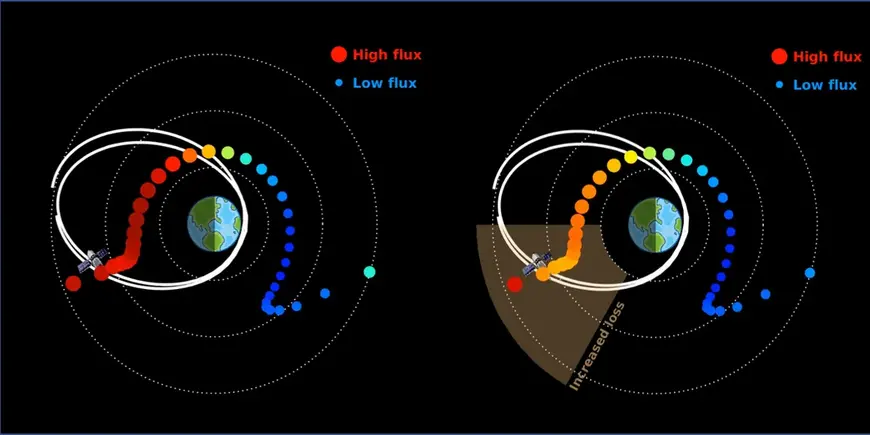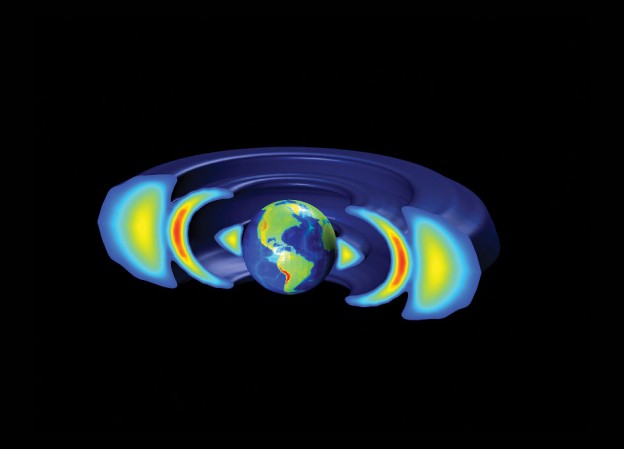New findings on the electron ring current enhancement
In the resent study, Bernhard Haas and co-authors found that the enhancement of the electron ring current during the geomagnetic storms is challenging to reproduce in the modeling, and it is attributed to a new missing scattering processes.
Charged particles from space are captured by the Earth’s magnetic field. They then flow in a circular path around the Earth, forming what is known as a ring current. Knowledge of its dynamics is important because it in turn affects the Earth’s magnetic field and atmosphere and can create dangerous conditions for satellites. In particular, the behaviour during geomagnetic storms caused by increased solar activity is not yet fully understood. Models used for this purpose have so far systematically overestimated the strength of the ring current. Researchers led by Bernhard Haas and Yuri Shprits from the GFZ German Research Centre for Geosciences have shown this in a study published in the journal Nature Scientific Reports. They analysed the particle trajectories during geomagnetic storms and identified a hitherto unrecognised particle loss process through scattering by so-called plasma waves.
See full article at GFZ website.
Electrons approach the speed of light when plasma density is low
In a recent study, Allison et al. found that depletions in plasma allowed electrons to accelerate to ultra-relativistic energies. The study used data from the Van Allen Probes as well as machine learning techniques to make these findings, which were published in Space Advances.
“This study shows that electrons in the Earth’s radiation belt can be promptly accelerated locally to ultra-relativistic energies, if the conditions of the plasma environment — plasma waves and temporarily low plasma density — are right. The particles can be regarded as surfing on plasma waves. In regions of extremely low plasma density they can just take a lot of energy from plasma waves. Similar mechanisms may be at work in the magnetospheres of the outer planets such as Jupiter or Saturn and in other astrophysical objects,” — Yuri Shprits
Check out press coverage in Science Daily and on the GFZ website and read the full paper here.
PAGER project started
EU Horizon 2020 project PAGER started. The kick-off meeting held in Potsdam at GFZ.
We’re excited to get our EU Horizon2020 project PAGER started! Kick-off meeting @GFZ_Potsdam pic.twitter.com/GNujSchUmT
— spacepager (@spacepager) January 28, 2020
The PAGER project will combine models from the Sun to the Earth’s inner magnetosphere + ensembles of physics-based & ML models to make predictions of space weather conditions 1-2 days in advance
Strong whistler mode waves observed in the vicinity of Jupiter’s moons
In the vicinity of Europa and Ganymede, that respectively have induced and internal magnetic fields, chorus wave power is significantly increased. The observed enhancements are persistent and exceed median values of wave activity by up to 6 orders of magnitude for Ganymede. Produced waves may have a pronounced effect on the acceleration and loss of particles in the Jovian magnetosphere and other astrophysical objects. The generated waves are capable of significantly modifying the energetic particle environment, accelerating particles to very high energies, or producing depletions in phase space density. Observations of Jupiter’s magnetosphere provide a unique opportunity to observe how objects with an internal magnetic field can interact with particles trapped in magnetic fields of larger scale objects.
Wave-induced loss of ultra-relativistic electrons in the Van Allen radiation belts
A geomagnetic storm on January 17, 2013, provided unique observations that finally resolved a long-standing scientific problem. (more…)
Dr. Tatiana Podladchikova Awarded International Alexander Chizhevsky Medal
Applied Mathematician Dr. Tatiana Podladchikova was awarded the International Alexander Chizhevsky Medal at the 12th European Space Weather Week, for major results in space weather.
Zebra stripes in space resolves a half-century mystery
This structure is pretty close to the Earth, which is important because people want to understand the environment where satellites operate. Usually plasma undergoes a number of different instabilities, and waves tend to move from one region in space to another, so everything you see is noisy, very short-lived, and on smaller scales. But this structure seems to be very persistent, highly coherent in space, and was remarkably organized and structured, which we didn’t know could exist to such high degree.
Unusual stable trapping of the ultrarelativistic electrons in the Van Allen radiation belts
RBM group scientists have successfully modeled and explained the unprecedented behavior of this third ring, showing that the extremely energetic particles that made up this ring, known as ultra-relativistic electrons, are driven by very different physics than typically observed Van Allen radiation belt particles. The region the belts occupy—ranging from about 1,000 to 50,000 kilometers above the Earth’s surface—is filled with electrons so energetic they move close to the speed of light.
‘Dropout’ Electrons Get Pushed out of Van Allen Belt
UCLA researchers showed that the missing electrons are swept away from the planet by a tide of solar wind particles during periods of heightened solar activity.
The data show that while a small amount of the missing energetic electrons did fall into the atmosphere, the vast majority was pushed away from the planet, stripped away from the radiation belt by the onslaught of solar wind particles during the heightened solar activity that generated the magnetic storm itself.
A Powerful Solar Storm Could Render Satellites Inoperable For Years
We found that in the absence of the cloud, electromagnetic waves accelerated large numbers of electrons to high speed in Earth’s inner radiation belt, causing a huge increase in radiation there. The inner radiation belt is densest at about 3000 kilometres above Earth’s equator, which is higher than low-Earth orbit. But the belt hugs Earth more tightly above high latitude regions, overlapping with satellites in low-Earth orbit.






